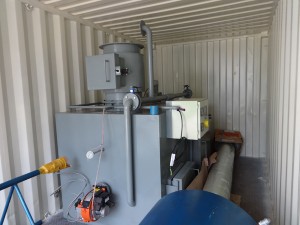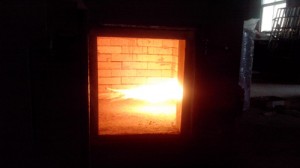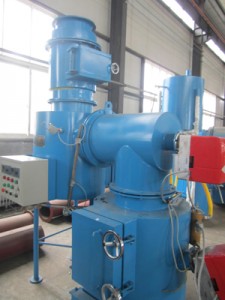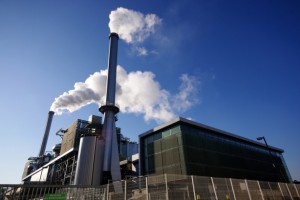Doubel Combustion Chamber
All Incinerators are Doubel Combustion Chamber with One Fuel Burner Each. After Burner Technology for Completely Combustion and Cleaner World.
Read MoreHigh Temperature Incineration
Temperature Range 800 Degree to 1200 Degree in Combustion Chamber. Temperature Thermocouple Monitor and Controller. High Quality Fire Brick and Refactory Cement.
Read MoreGet Lastest News
There are latest incinerator news like technical, public news, business tender for medical waste incinerator,animal incineration, pet cremation
Read MoreNanjing Clover Medical Technology Co.,Ltd.
Email: sales@clover-incinerator.com | Tel: +86-25-8461 0201
Regular model incinerator for market with burning rate from 10kgs to 500kgs per hour and we always proposal customer send us their require details, like waste material, local site fuel and power supply, incinerator operation time, etc, so we can proposal right model or custom made with different structure or dimensions.
Incinerator Model YD-100 is a middle scale incineration machine for many different usage: for a middle hospital sickbed below 500 units, for all small or big size family pets (like Alaskan Malamute Dog), for community Municipal Solid Waste Incineration, etc. The primary combustion chamber volume is 1200Liters (1.2m3) and use diesel oil or natural gas fuel burner original from Italy.
Latest Post
Ebola virus in Liberia
The Ebola virus-infected patients were burned in what was once a cattle slaughterhouse. Here the femur, hip and even skulls still unburnt sprawling creating a horrific scene.
Ian Birrel – reporter Dailymail, the UK has witnessed the grisly scene inside a crematorium identify patients infected with Ebola virus in Liberia. “When I walked into the place of cremation, surrounded by a wall outside Monrovia, I saw a pile of smoldering ash and smoke rising from it. I look closely, are scattered in the flickering flames which the bones, the femur and the hip joint, including even the skull. Here are the rest of the bodies of 15 victims of Ebola virus infection, “Ian said.
With Ian Birrel, the above is just one of the many horrific scenes that he faced in the Ebola outbreak in the West African country.
In the footsteps of the family have been infected with Ebola relatives, in Monrovia, reporters saw Ian Birrel extremely tragic circumstances of the victim. On the street, dead bodies because Ebola is still wandering. In the medical center, patients crowded. Beds are not enough to provide for the patient. In fact, for many people, the bed had before that patient mortality, were considered a “death cage”, making them fear that refusal bed.
Daniel James, a volunteer Red Cross in Kailahun, Sierra Leone told horror stories to bring back the dead, it emits cries a bit of a wheeze. Even the seasoned staff of the World Health Organization (WHO) also could not have imagined a corpse lying exposed for 3 days to produce such sounds. On an average day, they must be buried 6 dead bodies for Ebola infection.
By this time, the World Health Organization (WHO) has announced the number of deaths due to Ebola virus has risen to 3,000, but according to sources, this figure is only 1/3 the actual numbers. WHO also warned that, within the next 6 weeks, 17,000 people at risk of infection and death. The worst forecast also said 1.4 million people, especially in countries such as Liberia and Sierra Leone are at risk of infection.
CLOVER focussed on containment of Ebola
The past few months have been a very busy time for CLOVER. The outbreak of Ebola in West Africa has resulted in all of the Global aid organisations contacting CLOVER to support them in getting the necessary equipment to the effected regions.
The United Nations, UNOPS and local agents are now in constant contact with CLOVER in their attempts to stop the potential of further contamination by destroying medical waste streams at the source.
Regular model incinerator for market with burning rate from 10kgs to 500kgs per hour and we always proposal customer send us their require details, like waste material, local site fuel and power supply, incinerator operation time, etc, so we can proposal right model or custom made with different structure or dimensions. CLOVER have a wide range of medical Incinerators that allow for small batches of 10kg up to an impressive 600kg per hour. Many years of research and development has made CLOVER a company that is globally renowned and respected and are the go to company for a diverse set of organisations when such problems arise. The quality of our China manufactured product is of the highest standard and the warranties reflect the performance and life cycle of our Incinerators. All of the organisations have shown great interest in the Innovative and high performing mobile model that gives both performance and mobility, we currently have a large number of this model on route to the region as we speak.
incinerator-for-ebola
We are now talking to the individual countries about their ongoing requirements to support the process of this virus being contained and eventually eradicated. Our range of mobile incinerators are the ideal solution to enable mobile and instant waste management to areas that are restricted due to infrastructure and remoteness.
CLOVER will continue to strive on many fronts to ensure that our product range is the best in the Incinerator market and part of that process is the ability to service markets and disaster areas in the quickest possible time. This we will do with the utmost priority in servicing all of the Aid organisations and government agencies to win the battle against Ebola.
We urge everyone who can assist to do their utmost to help and support the people of West Africa, in the belief of bringing this problem to an end, Join us on our Social Media platforms to support the Ebola effort.
If you have any immediate requirements for one of our medical Ebola incinerators please contact with us know:
Website: www.clover-incinerator.com Email: sales@clover-incinerator.com Tel: +86-25-8461 0201
Sustainable Agriculture vs. Climate Change
Could the way we grow food actually help minimize the impact of climate change? Science not only says yes—it suggests conscientious agriculture could reverse the effects of climate change as well.
The global system of growing food, including land-use, feed, fertilizer, transportation, refrigeration, processing, and waste—is responsible for an estimated 30-50% of all global greenhouse gas emissions. These emissions have been increasing by about 1% per year—a major problem for the environment.
The key may very well be organic growing practices, or regenerative agriculture. Rodale Institute’s white paper “Regenerative Agriculture and Climate Change” states that “recent data from farming systems and pasture trials around the globe show that we could sequester more than 100 percent of current annual CO2 emissions with a switch to widely available and inexpensive organic management practices.” These practices involve maximizing carbon fixation—keeping the soil healthy by maintaining CO2 levels, in other words. Healthy soil can retain large quantities of water, prevent erosion, and help plants become more tolerant of extreme weather. Organic agriculture of this sort also uses 30-50% less fossil fuel than more industrial farms.
And regenerative organic agriculture isn’t anything new: humans have farmed in this way for generations, with proven results. The only new thing is the scientific validation that these practices can significantly impact the effect of climate change. Some of these studies are composed of more than thirty years of data, and new studies, such as the Tropical Farming Systems Trial (TFST) in Costa Rica, are bringing in thought-provoking results all the time.
While the ultimate goal should perhaps be decarbonizing the economy, there’s little chance of that occurring before an unacceptable level of warming gets locked in. That’s why interim steps such as working toward conscientious regenerative organic agriculture could make all the difference in minimizing climate change in the future.
How Obama Made Climate Change History this Week
Early this week, the Obama administration unveiled historic environmental rules to cut carbon pollution from power plants by 30% by 2030. The rules, announced formally by the Environmental Protection Agency, are the first time any president has moved to regulate carbon pollution from power plants – the largest single source of carbon dioxide emissions that cause climate change.
“For the sake of our families’ health and our kids’ future, we have a moral obligation to act on climate,” EPA Administrator Gina McCarthy said. “When we do, we’ll turn risks on climate into business opportunity. We’ll spur innovation and investment, and we’ll build a world-leading clean energy economy.”
The proposed rules also would result in reductions in particle pollutions, nitrogen oxides and sulfur dioxide by more than 25 percent, which EPA officials say would prevent in 6,600 premature deaths and 150,000 asthma attacks in children per year once fully implemented. The health improvements also would result in the avoidance of 490,000 missed work or school days, which the EPA says equals savings of $93 billion a year.
The proposal, although promoted fully by the president and Democratic leadership in Congress, ran into immediate opposition from business lobbies, Republicans in Congress and some Democrats facing tough election battles. The coal industry – which will be hit hardest by the new rules – said the regulations would hurt the economy and lead to power outages.
“If these rules are allowed to go into effect, the administration, for all intents and purposes, is creating America’s next energy crisis,” the American Coalition for Clean Coal Electricity said.
The problem is, the climate crisis will wipe us all out if we don’t do something big about it. What sort of world do we want our children to live in, or their children, or their children’s children? And for that matter, when does our planet just become completely unlivable? Will people believe that the time is right for a change then? No one ever said tackling a problem like climate change was going to be easy–it’s going to cost us a lot of money, effort, and yes, in some cases maybe even jobs (in many cases, it will actually create new jobs). But if we ignore it, or if we don’t do enough to combat it, the problem will only get worse. Isn’t the health of our planet more important than money? Than jobs? If we don’t figure something out, then someday money and jobs won’t matter anymore–because we’ll have completely destroyed our home, the place that allows us to live at all. It’s about time the U.S. got on board with climate change reform–especially since we’re one of the largest offenders. So bravo, Mr. Obama. Let’s just hope it’s not too late to make a difference.
China Arrests 60 For Waste Incinerator Protests
Early this week, protests erupted in China over plans to build a waste incinerator in an eastern city where officials didn’t seek public approval before proceeding. The demonstrations have been running for more than two weeks and turned violent on Saturday, with hundreds of police descending on to the streets of Yuhang, close to the eastern tourist city of Hangzhou. Previous to this week, officials repeated in state media that they would seek public support for the incinerator, but recently have made dozens of arrests in Hangzhou, with at least 10 demonstrators and 29 policemen injured.
Waste incinerators without proper emission filters can release the carcinogen dioxin, said Wu Yixiu, head of environmental group Greenpeace’s toxics campaign in East Asia. Several neighbors of the Hangzhou site cited that risk and noted that incinerators in Germany were required to filter out the toxin. Following large protests in March against a proposed paraxylene plant in the city of Maoming, officials said they would not proceed with facilities if public resistance remained high.
China’s fast growing cities produce around 160 million tons of domestic waste each year, according to domestic reports, and the country is planning around 300 such incinerators within the next three years as part of a “Great Leap Forward in garbage incineration”. For years, China witnesses tens of thousands of so-called “mass incidents” which have recently been linked to several environmental issues. In March, Li Keqiang, the prime minister, vowed to “declare war” on pollution and said his country would turn its back on “inefficient and blind development.”


















